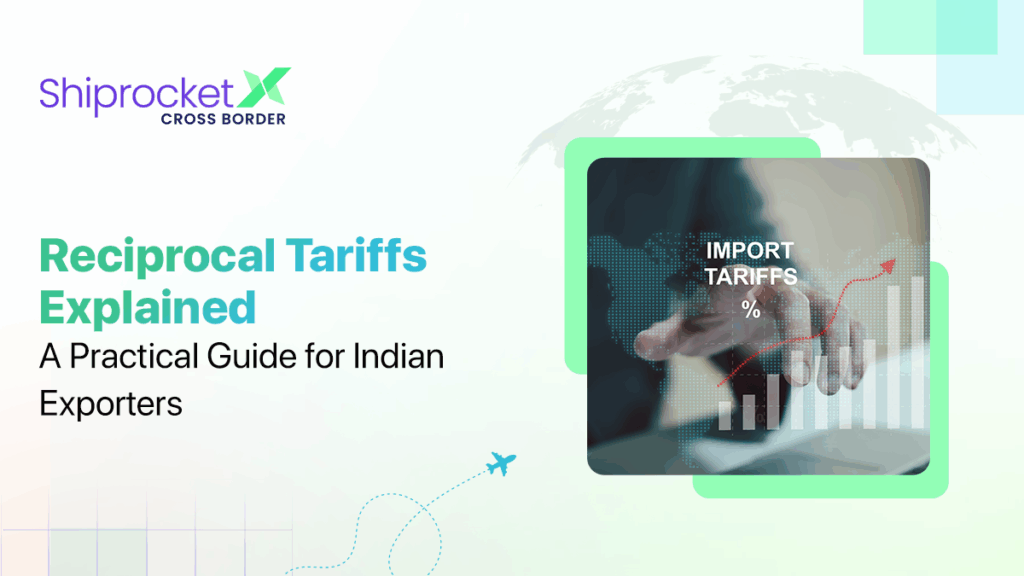Reciprocal Tariffs: Impact on Indian Exports Explained
- India’s Tariff Evolution: A Look at Key Changes Over Time
- Breaking Down the Role of Tariffs in International Trade
- Reciprocal Tariffs Defined
- The Reasons Behind the Rise of Reciprocal Tariff Policies
- A First for India: Facing Reciprocal Tariffs on Exports
- The Real Impact: Indian Exporters and Rising Trade Barriers
- US-India Trade Tensions Rise Under Donald Trump’s Policies
- Strengthening Global Fulfillment and Logistics with ShiprocketX
- Conclusion
Navigating global trade can be complex, especially when you’re an Indian exporter dealing with reciprocal tariffs. These tariffs, imposed as a response to another country’s duties, can reshape market access, cost structures, and profit margins. That’s why it’s important to understand how reciprocal tariffs work, why they’re used, and how they impact your exports.
This blog looks at reciprocal tariffs, the reasons behind their implementation, their actual impact, strategies to overcome associated challenges, and more.

India’s Tariff Evolution: A Look at Key Changes Over Time
India’s tariff policy has undergone significant changes over the past 100 years, evolving from colonial protectionism to modern-day strategic liberalisation.
India’s tariff journey began in 1923 with the establishment of the Indian Tariff Board, created to protect early industries, such as steel. In 1924, protective duties of up to 25% were imposed on iron and steel, reinforcing British economic interests while offering selective industrial support.
Following independence, India adopted a strict import substitution strategy. Tariffs soared, and licensing regimes became stringent. By the 1960s:
- Most consumer goods imports were banned
- Licenses were needed for intermediate and capital goods
- This high-protection regime made India one of the most closed economies globally.
Throughout the 1970s and 1980s, Indian businesses faced tariffs exceeding 200% on many goods when attempting to sell abroad. The government tightly controlled what could be imported or exported. Foreign companies were largely restricted from investing in or trading with India.
Although minor relaxations occurred in the late 1980s due to rising economic pressures, protectionism remained dominant.
A severe balance-of-payments crisis in 1991 forced a shift. India initiated the 1991 reforms with massive tariff reductions, the abolition of import licensing, and the devaluation of the rupee.
Eventually, tariffs dropped fast from 355% (1990-91) to 150% in 1991, and further down to 10% by 2007-08.
By the early 2000s, average tariffs on manufactured goods dropped from almost 72% to 15%.
India adopted World Trade Organisation (WTO) compliance in 2001, removing licensing on consumer goods. In 2000, the average tariff rate was 23.4%; it dropped to 6.59% in 2019, and by 2022, it further decreased to 4.6%.
This offered several benefits, from cheaper imports, more choice, and expanding global trade linkages. From 2008 onwards, tariff cuts slowed. India turned toward selective protectionism to boost domestic industries by imposing higher duties on automobiles, mobile phones, and textiles. India reduced tariffs on components for smartphones, solar cells, chemicals, and high-end motorcycles.
Despite this, trade openness improved:
- Non-agricultural goods tariffs averaged around 13.5%.
- Agricultural goods tariffs remained higher at 39%.
Yet in 2018, there was a sudden uptick. India increased its tariffs, just like many other countries, showing a global shift toward protecting domestic markets.
India’s average tariff on US imports rose from 11.59% in 2018 to 15.30% in 2022.
Meanwhile, US tariffs on Indian goods stayed stable. To avoid further trade tension, India is now reportedly considering tariff cuts on over 50% of US imports, proposing to narrow the tariff gap to under 4%, and seeking exemption from US retaliatory tariffs.
India is attempting to support its businesses without severing all trade and economic ties with the rest of the world. It’s a careful balancing act between being self-reliant and being part of the global economy. It’s boosting ‘Make in India’ via targeted hikes (e.g., EVs, semiconductors), and enhancing global value chain integration by cutting duties on imports.
Key changes include total customs tariff slabs to be reduced to eight, including a zero rate, with 2023–24 & 2025–26 budgets proposing tariff slab rationalisation.
The social welfare surcharge, a tax levied on customs duties when goods are imported into a country, is now exempted on 82 specific categories of goods.
Breaking Down the Role of Tariffs in International Trade
When a product is imported into a country from another, the government of the importing country charges a tax called a tariff. Tariffs make imports more expensive than domestic alternatives, giving local industries a pricing advantage. They also act as a significant source of government revenue and a tool for regulating international trade.
While global trade liberalisation has lowered tariffs overall, they haven’t disappeared. In fact, about two-thirds of international trade is now tariff-free, due to WTO rules and bilateral agreements. However, high tariffs persist in sensitive sectors, such as agriculture, textiles, and machinery.
Developing countries often face tariff escalation, where raw materials are taxed at a lower rate than finished goods, making it more difficult for them to export value-added products.
Here are some key functions of tariffs.
1. Protecting Domestic Industries
When a government imposes tariffs, it makes foreign products more expensive for consumers in the local market. This provides consumers with more incentives to purchase local goods. Governments sometimes impose tariffs to protect new or developing industries, known as infant industries, within their own country. The goal is to help these industries become self-sustaining in the long term. For example, tariffs on imported steel help domestic steel producers stay competitive.
2. Generating Government Revenue
Tariffs are a significant source of revenue, particularly in developing countries. In places where income or sales tax systems are weak, tariff collection becomes a primary method for funding public services. Revenue tariffs are set not to restrict trade but to raise funds.
3. Safeguarding Consumers and National Security
Tariffs are sometimes used to protect you from harmful imports and products that don’t meet safety standards or come from politically sensitive regions. They’re also used to support strategic sectors such as defence, food, and energy, ensuring those industries remain strong during crises.
4. Regulating Unfair Trade Practices
Tariffs can correct market distortions by targeting foreign subsidies, dumping practices (selling goods below cost), or currency manipulation. These trade practices can harm local businesses, making it difficult for them to compete, while tariffs can protect domestic industries and give them a fair chance to succeed. If you’re involved in manufacturing or trade, this means fairer competition and more predictable pricing.
5. Influencing Foreign Policy and Trade Negotiations
Governments often use tariffs as diplomatic leverage. If a trading partner violates trade agreements or engages in hostile actions, tariffs can apply pressure. However, such measures can backfire if they provoke retaliatory tariffs, sparking trade wars that affect you directly through reduced market access or disrupted supply chains.
6. Higher Prices for Local Businesses
The price of imported goods increases with tariffs. Instead of paying the extra cost, businesses pass it on to their customers. As a result, they have to pay more for the same product.
Over time, as the prices of many goods rise due to tariffs, the overall cost of living increases. Local businesses that rely on imported materials also face higher input costs, making it harder to remain competitive.
7. Slower Economic Growth
Tariffs reduce trade volume, limit product availability, and discourage cross-border investment. They often hit developing economies the hardest by blocking industrial exports and slowing economic development.
8. Trade Wars and Retaliation
When one country raises tariffs, others usually respond. This escalation can shrink global trade, weaken growth, and disrupt industries across the board, affecting everything from tech to agriculture.
Reciprocal Tariffs Defined
A reciprocal tariff is a trade policy measure where one country imposes tariffs and taxes on imported goods at the same rate as those levied by another country.
Here’s a clear example of how reciprocal tariffs work:
If Country X imposes a 15% tariff on steel imported from Country Y, then Country Y may retaliate by placing a 15% tariff on cars or other goods imported from Country X.
This strategy is used to mirror foreign tariffs and ensure that both trading partners face equal trade terms.
Reciprocal tariffs are used for several reasons:
- Fairness: They ensure domestic industries are not exposed to higher foreign tariffs.
- Negotiation Tool: They pressure other countries to reduce tariffs or enter into trade negotiations.
- Protection: They safeguard local businesses from countries using unjust tariffs or subsidies.
- Retaliation: They match or mirror tariffs imposed by another country, directly responding to trade practices perceived as unfair or barriers.
Reciprocity isn’t new in trade policy. In 1934, the US passed a law called the Reciprocal Tariff Act. Under this law, the US President gained the authority to negotiate tariff agreements directly with other countries. With the goal of mutually reducing tariffs, both the US and its trading partners would agree to lower their trade barriers in a fair and balanced way. These agreements required mutual concessions, leading to the creation of the General Agreement on Tariffs and Trade (GATT), a foundation of the WTO.
In 2025, the US introduced reciprocal tariffs against countries that imposed higher tariffs on American products, matching foreign rates to correct trade imbalances.
While reciprocal tariffs can drive fairer trade, they often come with unintended side effects:
- Trade Wars: Constant retaliation can spiral, hurting both economies.
- Higher Prices: Tariffs increase import costs, which may be passed on to consumers.
- Market Uncertainty: Businesses, especially exporters, face unpredictability in access and trade rules.
- Reduced Global Cooperation: These policies can strain diplomatic and economic ties.
Carefully balancing reciprocity and diplomacy is essential to avoid escalating tensions.
The Reasons Behind the Rise of Reciprocal Tariff Policies
Below are the major reasons behind the rise of reciprocal tariffs and why it matters to your economy.
1. Correcting Trade Imbalances
When a country imports more goods and services from other countries than it exports, it creates a trade deficit. This imbalance can hurt the economy in several ways. Reciprocal tariffs can reduce these trade deficits by making foreign goods more expensive and boosting the competitiveness of local products. By matching the high tariffs imposed by other nations, a country encourages more balanced trade flows.
2. Protecting Domestic Industries
Local businesses struggle when foreign producers benefit from unfair advantages like subsidies or ultra-low wages. Reciprocal tariffs are defensive strategies. By raising import costs, these policies support domestic production, preserve jobs, and allow industries to grow without being undercut by artificially cheap imports.
3. Responding to Unfair Trade Practices
If another country engages in trade practices that harm a country’s economy, like dumping, discriminatory tariffs, or currency manipulation, reciprocal tariffs offer a direct response. They act as a warning that means exploitative behaviour will be met with equal resistance, helping to restore fairness in global markets.
4. Gaining Negotiating Power in Trade Deals
Reciprocal tariffs are powerful bargaining tools. When a country imposes them, it sends a strong signal that it won’t tolerate one-sided deals. This strategy often prompts trading partners to return to the negotiating table, resulting in more equitable agreements and the removal of unfair barriers.
5. Promoting Economic Nationalism and Self-Reliance
Governments often frame reciprocal tariffs as part of a broader push for economic nationalism, a strategy that puts your country first. By reducing reliance on foreign goods, these tariffs stimulate innovation, encourage domestic manufacturing, and promote pride in locally made products. This builds resilience and long-term economic independence.
6. Addressing Political and Economic Pressures
Leaders face intense pressure to protect jobs, revive struggling industries, and maintain economic stability. Reciprocal tariffs enable them to demonstrate strength in trade and address public concerns. These policies boost national morale, create local employment opportunities, and demonstrate a commitment to economic sovereignty.
A First for India: Facing Reciprocal Tariffs on Exports
In 2025, the United States announced that it would charge an additional 26% tax on goods imported from India. This move counters what the US calls significant tariff and non-tariff barriers placed on American goods by India. This shift from multilateral to aggressive bilateral trade recalibrations may have long-term implications for exporters.
This tariff is lower than tariffs on China (54%), Vietnam (46%), and Thailand (36%), but higher than the EU’s 20%. For some products, such as shrimp, India now faces higher duties than Ecuador (10%), putting Indian exporters at a disadvantage. However, this also gives you a relative edge over competitors from highly tariffed nations in selected sectors.
If you operate in these industries, prepare for reduced margins and volumes:
| Industry | Drop in exports |
| Fish and crustaceans | 20.2% |
| Iron or steel articles | 18% |
| Diamonds, gold, and jewellery | 15.3% |
| Vehicles and auto parts | 12.1% |
| Electrical and telecom products | 12% |
Other impacted categories include plastics, petroleum products, carpets, organic chemicals, and machinery.
If you’re in the pharmaceuticals, energy (including solar panels), or copper sectors, you’re in a better position. These categories remain exempt from the country-specific tariff and will continue under the standard MFN rate.
In 2024, these exempted goods accounted for $20.4 billion or 22.7% of India’s exports to the US.
Steel, aluminium, automobiles, or auto parts now face a 25% tariff, affecting roughly $2.2 billion (2.5%) of India’s export volume to the US.
India exported a huge volume of products to the US in the year 2024, and the total value of those exports ranged from $81 billion to $86.81 billion. This export figure makes up almost 18% of India’s total exports to all countries combined for that year. If the tariffs remain in place for six months, you could see $8-$10 billion in trade disruption, shaving off about 0.2% of India’s GDP. India may lose export revenue, ranging from $5.79 billion to $6 billion in 2025 alone. This represents a 6.4% decrease compared to what India might otherwise have expected to earn from those exports.
The new tariff regime offers pockets of opportunity, especially where the US has penalised competing countries more harshly.
Here’s where you may gain:
| Industry | Potential rise |
| Textiles | 4.2% |
| Apparel | 3.2% |
| Ceramic products | 3.1% |
| Pharmaceuticals | 2.1% |
| Inorganic chemicals | 3% |
With China and Vietnam facing higher duties, your products may become more attractive to US buyers seeking cost-effective alternatives.
This is the first time India has faced large-scale reciprocal tariffs from a top trading partner like the US. You can use this period to prepare for long-term adaptation.
To adapt, you need to:
- Explore opportunities in the ASEAN, EU, African, and Middle Eastern markets and reduce reliance on the US.
- Add value, innovate, and differentiate. Higher tariffs demand stronger quality justification.
- Reach global buyers directly through Amazon Global, Alibaba, and niche B2B marketplaces.
- Work with trade bodies and export councils to stay updated and influence upcoming trade negotiations.
The Real Impact: Indian Exporters and Rising Trade Barriers
Rising trade barriers, tariffs, non-tariff barriers (NTBs), and quotas are directly affecting your profitability by increasing costs, restricting market access, and creating uncertainty. Here’s how:
Direct Cost Increases and Competitiveness Loss with Tariffs
High tariff rates in major markets shrink your margins and erode your competitiveness. EU tariffs on Indian textiles range from 8% to 10%, making the products less price-competitive than those from other countries.
Non-Tariff Barriers (NTBs)
NTBs have surged by nearly 30% over the last decade in developed economies. These include complex technical standards, sanitary and phytosanitary (SPS) requirements, and product testing and certification demands.
You may be spending 10%–15% of revenue just to meet these regulations, especially if you’re a small or medium exporter. Pharmaceuticals, textiles, and agro-products are hardest hit, with rejections, delays, and re-labelling requests now common.
Quotas and Volume Caps Hamper Growth
Even though less widespread, quotas still affect your access to key markets. Textiles and leather goods face volume restrictions, limiting how much you can export, even if demand exists. These caps disrupt effective production planning, leading to resources not being fully utilised.
Structural and Strategic Challenges
You may face the following systemic challenges that amplify the trade barrier impact, with export revenue declining.
- Sudden export bans, changes in duty structures, and regulatory tweaks shake buyer confidence.
- Currency volatility affects your pricing consistency and risk calculations.
- High export finance costs and credit constraints, especially for SMEs, reduce your ability to scale.
For example, India exported 40% less steel to the US in 2023 compared to the previous years, with tariff hikes being the primary reason for this drop.
Global Competition
Countries like Vietnam and Bangladesh are gaining ground due to lower labour costs, more favourable trade agreements with the EU and the US, and streamlined compliance frameworks. If you’re not keeping pace, you risk being left behind in key categories like garments, electronics, and consumer goods.
Indian exporters often lag in digital infrastructure to support global eCommerce, R&D investment for innovation and product development, skilled talent in export management, and international marketing. Without these capabilities, adapting to changing global requirements becomes harder.
US-India Trade Tensions Rise Under Donald Trump’s Policies
US-India trade tensions have escalated during Donald Trump’s second term, driven by aggressive tariff policies and hardline negotiation tactics from both sides.
In 2025, the Trump administration doubled US tariffs on steel imports to 50%, citing national security concerns. This move significantly impacts India, for whom the US is an essential market for steel and aluminium exports, potentially costing billions in lost revenue. Earlier, the US had already imposed 25% tariffs on these metals, which India challenged at the WTO.
India responded by notifying the WTO of its intention to impose retaliatory tariffs on US goods, arguing that the US duties had resulted in $1.9 billion in trade losses and that proper WTO procedures had not been followed. India requested formal talks with the US to challenge some tariffs imposed by the country. However, the US rejected that request by claiming that the tariffs were imposed for national security reasons. By invoking national security, the US argued that these tariffs are exempt from normal trade rules, and India cannot legally take countermeasures under WTO rules.
Trump has also announced new reciprocal tariffs on Indian goods, with some Indian exports facing duties as high as 26% under a revised US tariff framework. This has further strained trade relations and dashed Indian hopes for concessions.
Despite the tensions, both countries have continued negotiations. India has offered to reduce tariffs on select US products as part of efforts to secure a broader bilateral trade agreement (BTA). Talks have focused on tariff relief and market access, with India seeking assurances that no new tariffs will be imposed after any agreement is finalised.
The ongoing disputes have complicated efforts to reach a comprehensive trade pact. While President Trump has indicated that a deal with India is possible and could be close, the standoff over tariffs remains a major obstacle.
The standoff has affected thousands of jobs and increased costs in key sectors, with over $4.5 billion worth of Indian exports reportedly hit by US tariffs.
Both governments are holding firm, with India signalling a shift from a defensive to a more assertive approach in trade disputes, including challenging US tariffs at the WTO and signalling readiness for reciprocal action.
For now, the US has suspended the 26% tariff for 90 days, retaining a 10% baseline MFN tariff during this time.
Strengthening Global Fulfillment and Logistics with ShiprocketX
ShiprocketX is designed to help you expand your business beyond borders with ease. With a tech-driven platform, we simplify international shipping from India. Whether you’re shipping to the US, UK, UAE, Australia, Singapore, or Canada, we ensure smooth cross-border logistics, faster deliveries, and total visibility at every step.
With end-to-end solutions, from automated workflows and customs clearance to real-time tracking and analytics, you can scale globally while staying cost-effective.
Key benefits of using ShiprocketX:
- Ship to over 220 global regions with a strong courier network and localised delivery support.
- Choose from multiple shipping options and enjoy automated processes for timely delivery.
- Benefit from transparent billing, tax compliance, and zero paperwork issues.
- Keep customers informed with real-time updates via WhatsApp and email.
- Monitor customer behaviour, shipping performance, and courier efficiency in one dashboard.
- Establish trust with a custom tracking page that showcases your branding and promotional content.
- International shipping rates starting at just Rs. 306 per 50g.
- Simplify global returns and protect shipments with coverage up to Rs. 5000.
- Get expert guidance from a personal account manager to resolve issues quickly and efficiently.
Conclusion
Staying competitive in global trade starts with awareness. Reciprocal tariffs can either disrupt your export business or push you toward smarter, more resilient strategies. By understanding the mechanics behind these duties and adapting proactively, you gain control, even in uncertain markets. Monitor evolving trade policies, diversify your export destinations, and use available government schemes to your advantage. With the right approach, you’re not just reacting to tariffs, you’re staying one step ahead in global trade.






